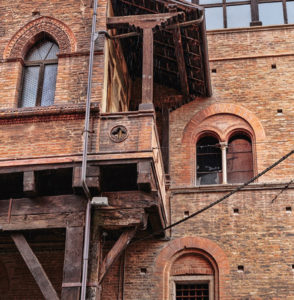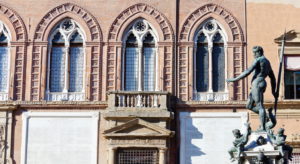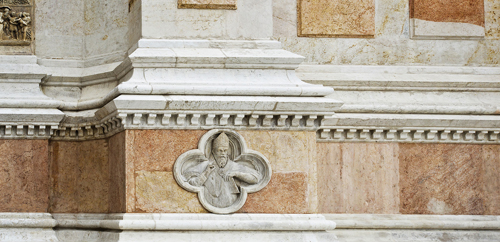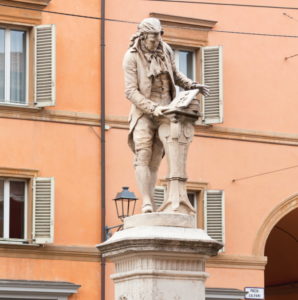A journey through the towers of Bologna with the nose up even while sitting on two wheels.
AIAS Bologna is a non-profit association founded in 1962 for the purpose of bringing together disabled people, their families, volunteers and operators. It provides care directly, or in agreement with public bodies, and supports services for the disabled and their families in various areas: school, work, technological aids and daily life.

It participates in programmes promoted by the European Union with initiatives recognized as a local model. The objective of AIAS is to ensure and promote the right of disabled people to a peaceful and integrated life in society. AIAS operates in the following sectors: associative, with social help desks, service orientation and rights protection. Stays, leisure activities, co-housing and expressive workshops.
Services to people, with home care, individual or group educational support; residential centres and day centres for teenagers and adults. Consultancy services with assistance to people, families and operators; support and training in agreement with the Public Administration, University and Schools. Projects at local and European level to prevent social exclusion; cultural promotion and disability policies; professional training for operators; and, dissemination of technologies for the disabled. ECC European Certification Body.
Thinking about an increasingly welcoming Bologna, AIAS offers a journey of about 3 km through the streets of the historic centre with nose up, looking at towers, palaces and basilicas.  The route starts from Piazza Roosevelt, where there are several parking areas reserved for guests with challenged mobility, the first tower of the itinerary, the Lapi tower, which is owned by the city since 1359, and incorporated in the walls of Palazzo D'Accursio on Via IV Novembre, then to Piazza Galileo, Torre degli Agresti (13th century), with its elegant seventeenth century restoration, in front of the police headquarters.
The route starts from Piazza Roosevelt, where there are several parking areas reserved for guests with challenged mobility, the first tower of the itinerary, the Lapi tower, which is owned by the city since 1359, and incorporated in the walls of Palazzo D'Accursio on Via IV Novembre, then to Piazza Galileo, Torre degli Agresti (13th century), with its elegant seventeenth century restoration, in front of the police headquarters.
Turn left onto Via Marescalchi, after via De’ Fusari and we arrive on Piazza dei Celestini: on the right, Vicolo Spirito Santo to visit Casa torre dei Catalani (13th century). On the square, at the corner with Via D'Azeglio on the first floor is the house museum of Bolognese singer-songwriter Lucio Dalla, next to the balcony the decoration that remembers him. We cross Via d'Azeglio to enter Corte Galluzzi where we find the Galluzzi tower (13th century), which brings to mind the tragic memory of Virginia Galluzzi and Alberto Carbonesi, the Bolognese Romeo and Juliet, today a bookstore with accessible entrance on via D’Azeglio 34/E (accessible wc).
From Corte Galluzzi, we exit through Piazza Galvani, we go left on Via dell'Archiginnasio, without entering under the portico. At the crossroads with via dei Musei (it is advisable to stay outside the portico), we turn right onto Via Clavature, where we can see the Sanctuary of Santa Maria della Vita, which houses the group of statues of the Lamentation on the Dead Christ by Niccolò dell’Arca, a masterpiece of fifteenth-century sculpture of unequalled dramatic force; then, on the right, going up Via Marchesana (slightly uphill) to building number 4 is the fourteenth-century tower of the Carrari, today a private residence. At the bottom we turn left onto Via De’ Foscherari, then right onto Via De' Toschi, we arrive at Piazza Minghetti to see the Toschi tower, cut off above the Case dei Caccianemici.
We continue to piazzetta del Francia, then left onto Via Castiglione, as far as piazza della Mercanzia, to arrive at Via Santo Stefano, at building number 4, is Torre degli Alberici, located next to thirteenthcentury Case Serracchioli, where the old shop built at the base in 1273 is still preserved. On the left, along Via del Luzzo, we arrive at Via Maggiore, where in the distance above the porticoes, towards Porta Mazzini (left side), we can see the Oseletti tower; we go through and continue along Via Castel Tialto, then go up Via San Vitale (right side portico) to Piazza di Porta Ravegnana.
 Here, we find the Two Towers symbol of medieval Bologna: the Asinelli (97 m) and the Garisenda (48 m) towers, mentioned in the Divine Comedy (there is a plaque with some verses).
Here, we find the Two Towers symbol of medieval Bologna: the Asinelli (97 m) and the Garisenda (48 m) towers, mentioned in the Divine Comedy (there is a plaque with some verses).
We continue along Via Rizzoli, up to building number 34, entering the Acquaderni Gallery, on the site of the ancient Church of San Giobbe.
We exit through Via Oberdan, to the right and, then, to the left, we reach Via San Niccolò (after the church), right on Via degli Albari and then on Via Albiroli, to visit Casa torre dei Guidozagni (right) and the tower of Prendiparte (left) known as the Coronata, now also a Bed & Breakfast.

We go up to Via Sant'Alò (plaque in memory of Guercino), then, on the right, to Via Altabella is the tower of the Azzoguidi, with the base made of selenite blocks. From here on the right, we look up to find the imposing bell tower of the Cathedral of San Pietro, built around a pre-existing cylindrical tower of the Byzantine age. Access to the Basilica is from Via Indipendenza. We cross the street to enter Via Manzoni (remaining in the portico) at building number 4, in the atrium of the Medieval Museum, the Casa Torre Conoscenti (XIII century) - (accessible wc). We return to Via Indipendenza (right side), crossing Via Ugo Bassi and Piazza del Nettuno, we pass under the vault of the Podestà (acoustic effect at the two opposite corners) up to piazza Re Enzo where the Lambertini tower is located, in a corner in Palazzo Re Enzo, called “of the women” because it was once used as a women's prison.
 From here, we can see the Uguzzoni tower appear over roofs of homes. We cross Piazza Maggiore to admire the Clock Tower and the facade of Palazzo D'Accursio with the statue of Pope Gregory XIII.
From here, we can see the Uguzzoni tower appear over roofs of homes. We cross Piazza Maggiore to admire the Clock Tower and the facade of Palazzo D'Accursio with the statue of Pope Gregory XIII.
From Piazza Maggiore, we return to Piazza del Nettuno: on the right, we see Torre dell'Arengo, above the Voltone, opposite to it, at the beginning of Via Indipendenza, we see the Scappi tower, incorporated into the homonymous palace and linked to King Enzo’s attempt to flee. We continue by accessing the courtyards of the municipal building (accessible wc) and then exit right onto Via Ugo Bassi.
At the corner with via Veneziani, we see the last tower of our itinerary: Torrone, used as a prison until 1830. And here, our route ends, at the parking lot of Piazza Roosevelt.
For more information:
www.aiasbo.it
www.comune.bologna.it - sportello sociale (social help desk) - services offered - services for accessibility




